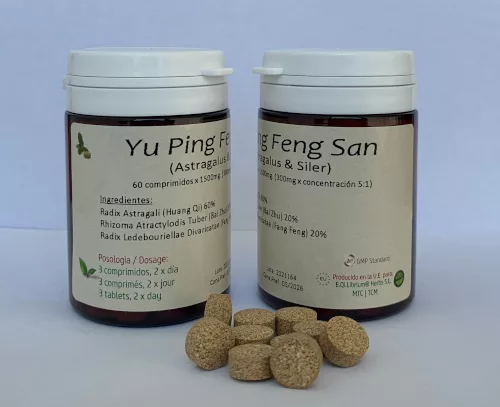In Traditional Chinese Medicine, we analyze herbs individually and in formulas. Formulas are created by combining individual herbs in certain measurements. The combinations, percentages of each herb, and preparation techniques create different herbal medicines.
At the end of this pandemic year, in the middle of the third wave, I want to introduce you to the Chinese herbal formula “Yu Ping Feng San.”
Most traditional herbal formulas go back more than 2,000 years. Yu Ping Feng San is one of the “newer” formulas. It was first described in “Dan Xi Xin Fa” by Zhu Danxi in the Yuan Dynasty (A.D. 1279-1368). (1) The name literally means “Jade Screen Powder”. Yu means jade. Jade is very valuable in Chinese culture. It is considered to be a lucky stone. In China it is known as “The Stone of Heaven”. There is a saying in China that “gold is valuable while jade is priceless”. Jade is seen as protective from bad luck and is a symbol of renewal and longevity. Ping Feng means wind screen or fence. Feng is the wind. In Chinese medicine, pathogens are described as “wind”. This refers to viruses, bacteria, poisons, and also allergens. San means powder. The name of the formula points out the function: it is a powder to protect the body from pathogens.
This formula strengthens the Wei qi. In TCM “Qi” is the energy, essence of life. It is accepted that there are different kinds of Qi. “Wei Qi” or Protective Qi is the most exterior Qi level of our body. It is described that Wei Qi surrounds our physical existence and protects from attacks coming from outside. If we want to translate this traditional philosophical explanation to medicine, Wei Qi correlates partly to our immune system, such as the primary immune response of our bodies. In our immune systems, there are different stages of the immune response, innate and adaptive. Accordingly, Wei Qi correlates with the innate immune response, our first line of defense. As traditionally indicated, this formula helps to strengthen our immune system before the disease enters deeper stages. Because of this, we need to use the YPFS before we get sick. (2) I recommend using this formula when you feel sleep deprived, exhausted, and are just not at 100%, as a boost to your immunity.
The formula has 3 herbs in it:
1. Astragalus Radix (Huang Qi):
AR is called “the senior of all herbs” in the fundamental textbook “Essentials of Materia Medica” (A.D. 1694). As one of the best immune tonic herbs, it stabilizes and strengthens the immune system.
Astragalus is a genus from large and complex plant group of the pea family (Leguminosae) (3) There are about 2000 species of astragalus in the Northern Hemisphere. TCM practitioners’ knowledge of this immunostimulant herb is ancient. Huang Qi is used to strengthen innate immunity, but if the pathogen enters the body, it can guide it to the deeper levels. Translated, this means that it may worsen the symptoms if the disease has already started to cause a fever.
2. Antractylodis macrocephalae rhizome (Bai Zhu):
This herb is bitter, sweet and warm in nature. It is shown to have mitigating effects on inflammation, hepatotoxicity, ulcers, cancer, and obesity.
3. Saposhnikoviae radix (Fang Feng):
This herb name translates to “expel wind” (remember that wind refers to a variety of pathogens in TCM).
The clinical symptoms you may have when you use YPFS:
Spontaneous sweating, frequent colds, aversion to wind, fatigue, pale and shiny complexion.
These are the first symptoms and usually, resolve in the 24-48 hour window of any external pathogen-related infection. It is also shown that YPFS can help with allergic rhinitis (allergies) (2).
I use YPFS when I feel weak, sleep-deprived, tired, and nowadays when I know that I will be exposed to crowded environments, and definitely before I travel.
Contact Physio Logic TODAY to get your TCM appointment on the books!
- Du CY, Choi RC, Dong TT, Lau DT, Tsim KW. Yu Ping Feng San, an ancient Chinese herbal decoction, regulates the expression of inducible nitric oxide synthase and cyclooxygenase-2 and the activity of intestinal alkaline phosphatase in cultures. PLoS One. 2014 Jun 26;9(6):e100382. doi: 10.1371/journal.pone.0100382. PMID: 24967898; PMCID: PMC4072625.
- Luo Q, Zhang CS, Yang L, Zhang AL, Guo X, Xue CC, Lu C. Potential effectiveness of Chinese herbal medicine Yu ping feng san for adult allergic rhinitis: a systematic review and meta-analysis of randomized controlled trials. BMC Complement Altern Med. 2017 Nov 6;17(1):485. doi: 10.1186/s12906-017-1988-5. PMID: 29110710; PMCID: PMC5674829.
- Li X, Qu L, Dong Y, Han L, Liu E, Fang S, Zhang Y, Wang T. A review of recent research progress on the astragalus genus. Molecules. 2014 Nov 17;19(11):18850-80. doi: 10.3390/molecules191118850. PMID: 25407722; PMCID: PMC6270929.
